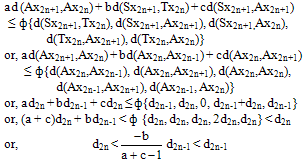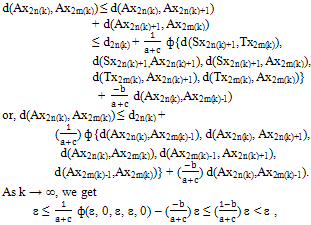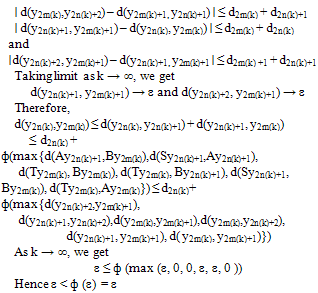-
Paper Information
- Next Paper
- Previous Paper
- Paper Submission
-
Journal Information
- About This Journal
- Editorial Board
- Current Issue
- Archive
- Author Guidelines
- Contact Us
American Journal of Mathematics and Statistics
p-ISSN: 2162-948X e-ISSN: 2162-8475
2011; 1(1): 17-20
doi: 10.5923/j.ajms.20110101.03
Compatible Mappings and Some Common Fixed Point Results
1Department of Applied Mathematics, Institute of Technology, Banaras Hindu University, Varanasi, 221005, India
2Department of Mathematics and Statistics, Haflong Govt. College, Haflong, Dima Hasao, Assam, 788819, India
Correspondence to: T. Som , Department of Applied Mathematics, Institute of Technology, Banaras Hindu University, Varanasi, 221005, India.
| Email: |  |
Copyright © 2012 Scientific & Academic Publishing. All Rights Reserved.
The present paper deals with some common fixed point results on a metric space for compatible mappings satisfying a more general inequality condition. The results obtained generalize the fixed point results of Mukherjee (1981) and Som (1985) and many others in turn.
Keywords: Compatible Mappings, Metric Space, Fixed Point
Cite this paper: T. Som , A. Choudhury , "Compatible Mappings and Some Common Fixed Point Results", American Journal of Mathematics and Statistics, Vol. 1 No. 1, 2011, pp. 17-20. doi: 10.5923/j.ajms.20110101.03.
Article Outline
1. Introduction
- The idea of common fixed point was initially given by Jungck[3], where the mappings considered were commuting. There after many generalizations of this common fixed point result were obtained by several mathematicians viz., Hadzic[2], Meade and Singh[11], Pathak[7], Yeh[13] etc. The commutativity condition of mappings was further replaced by a weaker type of notion viz., weakly commuting mappings as introduced by Sessa[8]. Several common fixed point theorems have been proved for such mappings by many authors viz., Sessa et. al.[9], Fisher and Sessa[1] and others. The notion of weak commutativity has been further weakened by the notion of compatible mappings, introduced by Jungck[4] which gave a new direction towards more comprehensive results in the context of common fixed point in metric fixed point theory. In this paper we obtain some common fixed point results for compatible mappings satisfying more general inequality condition which mainly generalize the results of Mukherjee[6], Som[10] and others in turn.
1.1. Definition I (Sessa[8]) :
- Two self mappings A and S of a metric space (X, d) are called weakly commuting if

1.2. Definition II (Jungck[4]) :
- Let f and g be two self maps on a metric space (X,d). f and g are called compatible if
 whenever {xn} is a sequence such that limn→∞ fxn = limn→∞gxn = t for some t in X.The Banach contraction theorem assures fixed point for a mapping which is necessarily continuous. However Taskovic[12] proved the following fixed point result for a self mapping which is not necessarily continuous.
whenever {xn} is a sequence such that limn→∞ fxn = limn→∞gxn = t for some t in X.The Banach contraction theorem assures fixed point for a mapping which is necessarily continuous. However Taskovic[12] proved the following fixed point result for a self mapping which is not necessarily continuous.1.3. Theorem I
- Let T be a self mapping of a complete metric space (X,d) satisfying(1) ad(Tx,Ty) + bd(x,Tx) + cd(y,Ty) - min {d(Tx,y), d(x,Ty)} ≤ qd(x,y)with a > q+1 and a+c > 0. Then T has a unique fixed point in X.Generalizing the above result of Taskovic and that of Mukherjee[6] for common fixed point of two mappings, Som[10] obtained the following results.
1.4. Theorem II
- Let T and S be two self mappings of a complete metric space (X,d) satisfying (2) ad (Tx,Sy) + bd (x,Tx) + cd (y,Sy) – min {d(x,Sy), d (Tx,y)} ≤ q d(x,y)for all x,y ∈ X, where a,b,c ≥ 0, q > 0 with a > q+1 and a+c > 0. Then T and S have a unique common fixed point.
1.5. Theorem 1.3.
- Let (X,d) be a complete metric space and T and S be a self mappings of X satisfying (3) ad (Tx,Sy) + bd(x,Tx) + cd(y,Sy) – min{ d(x,Sy), d(Tx,y)} ≤ q max{d(x,y), d(x,Tx), d(y,Sy),[d(x,Sy) + d(Tx,y)]/2}for all x,y ∈ X, where a,b,c ≥ 0 , q > 0 with a > q +1 and a + c > 0. Then T and S have a unique common fixed point.Unifying the mapping conditions of above theorems we obtain few common fixed point results in the next section.
2. Main Results
- Our first theorem extends the result of Som[10] in respect of the mapping condition.
2.1. Theorem I
- Let A be a self mapping of a complete metric space (X,d) and S ,T be two continuous self mapping of X satisfying (i) the pairs {A,S} and {A,T} are compatible with A(X)⊂S(X) ∩T(X).(ii) ad(Ax,Ay) + bd(Sx,Ty) + cd(Sx,Ax) ≤ ф{d(Sx,Ty), d(Sx,Ax), d(Sx,Ay), d(Ty,Ax), d(Ty,Ay)}where a+b+c > 1 and ф: R+5→R+ is non-decreasing in each coordinate variable and for any t > 0, ф( t, t, a1t, a2t, t) < t , a1 + a2 = 3. Then A, S and T have a unique common fixed point in X. Proof: Let x0 be any arbitrary point in X. Then Ax0 ∈X. Since A(X) ⊂ S(X), there exists a point x1 ∈ X such that Ax0 = Sx1. Further since A(X) ⊂ T(X), there is a point x2 ∈ X such that Ax1 = Tx2. In general we have the sequence {xn} in X such that
 Here we claim that {dn} is a decreasing sequence. Suppose that d2n > d2n-1 for some n. Putting x = x2n+1, y = x2n in (ii), we get
Here we claim that {dn} is a decreasing sequence. Suppose that d2n > d2n-1 for some n. Putting x = x2n+1, y = x2n in (ii), we get i.e., a contradiction. Therefore {dn} is decreasing sequence of non negative reals, so it converges to zero. Now, we show that {Axn} is a Cauchy sequence. Since limn→∞ dn = 0, it is sufficient to show that {Ax2n} is a Cauchy sequence. Suppose that it is not so. Then there is an ε > 0 and for each even integer 2k, k = 0,1,2,… there exists even integer 2n(k) and 2m(k) with 2k < 2n(k) < 2m(k) such that (iii) d(Ax2n(k), Ax2m(k)) > εLet for each even integer 2k, 2m(k) be least positive integer exceeding 2n(k) satisfying (iii) , then(iv) d(Ax2n(k),Ax2m(k)-2) ≤ ε and d(Ax2n(k),Ax2m(k)) > ε As such for each even integer 2k, we have ε < d(Ax2n(k),Ax2m(k) ) ≤ d(Ax2n(k),Ax2m(k)-2 ) + d2m(k)-2 + d2m(k)-1So by (iv) and as k→∞, we get (v) limk→∞ d(Ax2n(k), Ax2m(k)) = ε Now using (v) in the triangle inequalities|d(Ax2n(k), Ax2m(k)-1) – d(Ax2n(k), Ax2m(k))| ≤ d2m(k)-1and |d(Ax2n(k)+1, Ax2m(k)-1) – d(Ax2n(k), Ax2m(k))| ≤ d2m(k)-1 + d2n(k) .Taking limit as k → ∞, we get d(Ax2n(k), Ax2m(k)-1 ) → ε and d(Ax2n(k)+1, Ax2m(k)-1) → ε.Then,
i.e., a contradiction. Therefore {dn} is decreasing sequence of non negative reals, so it converges to zero. Now, we show that {Axn} is a Cauchy sequence. Since limn→∞ dn = 0, it is sufficient to show that {Ax2n} is a Cauchy sequence. Suppose that it is not so. Then there is an ε > 0 and for each even integer 2k, k = 0,1,2,… there exists even integer 2n(k) and 2m(k) with 2k < 2n(k) < 2m(k) such that (iii) d(Ax2n(k), Ax2m(k)) > εLet for each even integer 2k, 2m(k) be least positive integer exceeding 2n(k) satisfying (iii) , then(iv) d(Ax2n(k),Ax2m(k)-2) ≤ ε and d(Ax2n(k),Ax2m(k)) > ε As such for each even integer 2k, we have ε < d(Ax2n(k),Ax2m(k) ) ≤ d(Ax2n(k),Ax2m(k)-2 ) + d2m(k)-2 + d2m(k)-1So by (iv) and as k→∞, we get (v) limk→∞ d(Ax2n(k), Ax2m(k)) = ε Now using (v) in the triangle inequalities|d(Ax2n(k), Ax2m(k)-1) – d(Ax2n(k), Ax2m(k))| ≤ d2m(k)-1and |d(Ax2n(k)+1, Ax2m(k)-1) – d(Ax2n(k), Ax2m(k))| ≤ d2m(k)-1 + d2n(k) .Taking limit as k → ∞, we get d(Ax2n(k), Ax2m(k)-1 ) → ε and d(Ax2n(k)+1, Ax2m(k)-1) → ε.Then, a contradiction. Hence {Axn} is a Cauchy sequence in X and so by completeness of X, {Axn} converges to a point z ∈ X. Consequently the subsequences {Sx2n+1} and {Tx2n} of {Axn} also converge to z. Since {A, S} is compatible, we get lim n→∞(ASx2n+1,SAx2n+1) → 0and therefore lim n→∞ASx2n+1 lim n→∞SAx2n+1 = S(lim n→∞ Ax2n+1) = Sz.Now we show that Sz = z. Suppose Sz ≠ z , then from (ii) we have ,
a contradiction. Hence {Axn} is a Cauchy sequence in X and so by completeness of X, {Axn} converges to a point z ∈ X. Consequently the subsequences {Sx2n+1} and {Tx2n} of {Axn} also converge to z. Since {A, S} is compatible, we get lim n→∞(ASx2n+1,SAx2n+1) → 0and therefore lim n→∞ASx2n+1 lim n→∞SAx2n+1 = S(lim n→∞ Ax2n+1) = Sz.Now we show that Sz = z. Suppose Sz ≠ z , then from (ii) we have , In the limiting case, we get
In the limiting case, we get a contradiction. Thus z is a fixed point of S. Similarly taking x = z and y = x2n in (ii), we can show that z is a fixed point of A. Lastly we claim that z is a fixed point of T. Suppose it is not so, then
a contradiction. Thus z is a fixed point of S. Similarly taking x = z and y = x2n in (ii), we can show that z is a fixed point of A. Lastly we claim that z is a fixed point of T. Suppose it is not so, then  Since A is compatible with T we have
Since A is compatible with T we have and so
and so  Now from (ii), we have
Now from (ii), we have  As n → ∞, we get
As n → ∞, we get  a contradiction, since a+b > 1. Therefore Tz = z. Thus z is a common fixed point of A,S and T. From (ii), we can easily show that the fixed point is unique. This completes the proof.In that follows we give a common fixed point result for four self mappings satisfying a more general inequality condition. This in turn generalizes the fixed point result of Mukherjee[6].
a contradiction, since a+b > 1. Therefore Tz = z. Thus z is a common fixed point of A,S and T. From (ii), we can easily show that the fixed point is unique. This completes the proof.In that follows we give a common fixed point result for four self mappings satisfying a more general inequality condition. This in turn generalizes the fixed point result of Mukherjee[6].2.2. Lemma (Kang et.al.[5]) :
- Let (X,d) be a metric space, K ⊂ X and A, S : K → K be compatible mappings. If {xn} is a sequence in K and limn→∞ Axn = limn→∞ Sxn = t for some t ∈ K,then limn→∞ ASxn = St if S is continuous.
2.3. Theorem II
- Let (X,d) be a complete metric space and A,B,S and T be self mappings of X. Suppose that S and T are continuous. The mapping pairs {A,S} and {B,T} are compatible with A(X) ⊂ T(X) and B(X) ⊂ S(X) and there exists a upper semi continuous function ф:[0,∞) → [0,∞), which is non decreasing and ф (t) < t for all t > 0. Let A,B,S and T satisfy the condition :(vi) d(Sx,Ty) ≤ ф(max{d(Ax,By), d(Sx,Ax), d(Ty,By), d(Ty,Bx), d(Sx,By), d(Ty,Ay)}) Then A, B, S and T have a unique common fixed point in X.Proof: Since A(X) ⊂ T(X) and B(X) ⊂ S(X), we can choose a sequence {xn} in X such that Sx2n = Bx2n-1 and Tx2n-1 = Ax2n-2for all n in the set N of all positive integers. Let (vii) y2n-1 = Tx2n-1 = Ax2n -2 and y2n = Sx2n = Bx2n-1 for n ∈ N Now from (vi), we have
 Let d2n = d(y2n,y2n+1) > 0 for all n = 0,1,2,… . Then we get d2n-1 ≤ ф (max{d2n, d2n, d2n-1, 0, 0, d2n-1}) = ф(d2n) < d2n. Hence d2n-1 < d2n. Similarly we can show that d2n< d2n+1. Therefore {dn} is non decreasing sequence in R. We now show that {yn} is a Cauchy sequence. Suppose that it is not so, then there exists an ε > 0 such that for any integer 2k, k = 0,1,2,… there exist two sequences {2m(k)}k and {2n(k)}k, k∈N with 2k < 2n(k) < 2m(k), for which (viii) d(y2n(k),y2m(k)) > ε If 2m(k) denote the smallest integer exceeding 2n(k) satisfying (viii), we have (ix) d(y2n(k),y2m(k)-2) ≤ ε Then, ε < d(y2n(k), y2m(k))) ≤ d(y2n(k),y2m(k)-2) +d2m(k)-2 +d2m(k)-1.So by (ix) and as k → ∞, we get (x) limk→∞d(y2n(k), y2m(k)) = ε Now using (x) in the triangle inequalities
Let d2n = d(y2n,y2n+1) > 0 for all n = 0,1,2,… . Then we get d2n-1 ≤ ф (max{d2n, d2n, d2n-1, 0, 0, d2n-1}) = ф(d2n) < d2n. Hence d2n-1 < d2n. Similarly we can show that d2n< d2n+1. Therefore {dn} is non decreasing sequence in R. We now show that {yn} is a Cauchy sequence. Suppose that it is not so, then there exists an ε > 0 such that for any integer 2k, k = 0,1,2,… there exist two sequences {2m(k)}k and {2n(k)}k, k∈N with 2k < 2n(k) < 2m(k), for which (viii) d(y2n(k),y2m(k)) > ε If 2m(k) denote the smallest integer exceeding 2n(k) satisfying (viii), we have (ix) d(y2n(k),y2m(k)-2) ≤ ε Then, ε < d(y2n(k), y2m(k))) ≤ d(y2n(k),y2m(k)-2) +d2m(k)-2 +d2m(k)-1.So by (ix) and as k → ∞, we get (x) limk→∞d(y2n(k), y2m(k)) = ε Now using (x) in the triangle inequalities  a contradiction. Hence {yn} is a Cauchy sequence in X. Suppose yn → y ∈ X, then the subsequences {y2n} and {y2n-1} also converge to y. Since {A,S} and {B,T} are both compatible, it follows from the continuity of S and T that (xi) Ty2n-1 → Ty, By2n-1 → Ty, Sy2n → Sy, Ay2n → Sy Again from (vi), we get
a contradiction. Hence {yn} is a Cauchy sequence in X. Suppose yn → y ∈ X, then the subsequences {y2n} and {y2n-1} also converge to y. Since {A,S} and {B,T} are both compatible, it follows from the continuity of S and T that (xi) Ty2n-1 → Ty, By2n-1 → Ty, Sy2n → Sy, Ay2n → Sy Again from (vi), we get By the upper semi continuity of ф and (xi), we get
By the upper semi continuity of ф and (xi), we get This implies Sy =Ty. Similarly we can obtain that(xii) Sy = By, Ty = Ay and so, Ay = By = Sy = Ty Again from (vi), we have
This implies Sy =Ty. Similarly we can obtain that(xii) Sy = By, Ty = Ay and so, Ay = By = Sy = Ty Again from (vi), we have Therefore y = Ty. Hence y = Ty = Ay = By = Sy. Thus y is the common fixed point of A, B, S and T.To prove uniqueness let x (≠ y) be another common fixed point of A,B,S and T. Then from (vi), we get
Therefore y = Ty. Hence y = Ty = Ay = By = Sy. Thus y is the common fixed point of A, B, S and T.To prove uniqueness let x (≠ y) be another common fixed point of A,B,S and T. Then from (vi), we get and so, we get x = y. Thus A, B, S and T have a unique common fixed point y in X.
and so, we get x = y. Thus A, B, S and T have a unique common fixed point y in X. 3. Conclusions
- The inequality conditions (ii) and (vi) of our respective results are more general by involving a ф function than the conditions (1), (2) and (3) of the results of Som[10], Taskovic[12] and that of Mukherjee[6]. Moreover the nature of the functions are more restricted due to compatibility and we get common fixed points for such mappings.
 Abstract
Abstract Reference
Reference Full-Text PDF
Full-Text PDF Full-Text HTML
Full-Text HTML